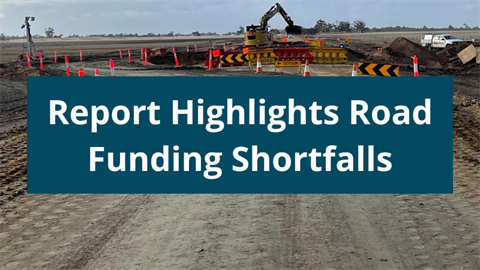Report Highlights Road Funding Shortfalls
Published on 24 November 2023

New research highlights billion-dollar local road funding shortfall
A new independent research report has recommended that Australian councils are provided with an extra $1 billion in federal funding each year to maintain and upgrade their local roads.
The Grattan Institute’s Potholes and pitfalls: how to fix local roads report recommends that the Government increases untied federal funding to councils through Financial Assistance Grants by $600 million per year, and Roads to Recovery funding by $400 million per year.
This aligns with the Australian Local Government Association’s call for Financial Assistance Grants to be restored to at least one percent of Commonwealth taxation revenue and Roads to Recovery funding increased to $800 million per year.
One of the key issues identified in the Grattan Institute’s report is that federal funding to councils is not keeping up with increases in road construction and maintenance costs.
Yarriambiack Shire Council Mayor Cr Kylie Zanker said, “Our current road network has seen an injection of funds over previous years and most recently due to the October 2022 rain event. We are currently meeting the level of service required for our sealed network but if funding ceases the standard and levels of service will decrease rapidly. Council aims to ensure that it can maintain its infrastructure assets at the expected levels, while at the same time continuing to deliver the services needed by the community. To bridge the infrastructure gap between our needs and funding available, Council invested $6.836 million in renewal works during the 2022/23 year. This was funded predominately from grants. During this year, we delivered $8.931 million Road and associated infrastructure projects across the shire”.
“Our challenges include the lack of available quarries and gravel pits within our Shire, and neighbouring shires that contribute to increases in costs associated with cartage and road building. Cost of materials and labour has dramatically increased in recent years and has put significant pressure on every aspect of Council’s operations”, Cr Zanker added.
The report also highlights that many regional, rural and remote councils face additional challenges in maintaining their local roads, based on their large geographic size and relatively small ratepayer base.
“Yarriambiack Shire maintains a total of 4,821 kilometres of roads, which includes more than 850 kilometres in sealed roads and 1,250 kilometres of gravel roads. This equates to over 1.3km of road per Shire resident. The Council’s financial position continues to remain sound, however, ongoing underlying surpluses continue to be a challenge with the Council reliant on funding from other levels of government to ensure its long-term financial sustainability. As a small rural shire we have limited ability to increase our own source revenue, and are therefore heavily reliant on grants from Federal and State. Untied federal funding is not going to the Local Government Areas that need it most. This type of funding is vital for the ongoing maintenance of our road network to ensure they are fit-for-purpose and safe that allows each individual Council to direct the funding to where it’s needed most”, Cr Zanker added.
The Grattan Institute has also recommended that the Federal Government establish a new $200 million per year fund to assess and upgrade local roads identified as priority freight routes.
“Agriculture is our largest industry contributing 37% of total output and our largest employing industry with 28% of total jobs. Our farmers produce 11% of Victoria’s gross farm value of wheat, 16% of barley, 19% of chickpeas, 45% of lentils, and 11% of other pulses. Council’s designated heavy vehicle routes are vital for the local, regional and national economy. These routes require extra funding for upgrades to meet the required level of standard. Similarly, the gravel network is an ongoing issue to meet levels of service for farm gate to market vehicle movements as the evolution of agriculture has seen increased machinery movement over greater distances, having a significant impact on all roads within the network”, Cr Zanker added.
The Federal Government is currently undertaking a review of Australia’s Infrastructure Investment Pipeline, which also includes local government road funding programs.
“Additional funding alone will not be enough to solve the problems faced by our council. To effectively manage roads, we require support, staff training, improved data specifics and technology to implement our programs. We are invested in improving our data capture and reporting methods and systems, however this takes time, resources and funds. These elements of effective road management are often the unseen activities of Council that ensure the end result delivers on local priorities”, Cr Zanker said.
“Funding roads based on densely populated areas is not sustainable for rural and regional areas such as Yarriambiack and the Wimmera region. Favouring densely populated areas through the proposed redistribution model will only provide more funding to those Council’s who already have a substantial revenue source and disadvantages rural Council’s that have limited abilities to raise revenue. Our aim is for better quality and safer roads, and this is a national priority that concerns all levels of government and we will continue to advocate for our communities to ensure our funding is fair and equitable, regardless of what area of Australia they reside”, Cr Zanker add.
Further information, including the link to download the Grattan Institute’s Report, Potholes and pitfalls: how to fix local roads can be found on Council’s website at www.yarriambiack.vic.gov.au.
END OF RELEASE
Cr Kylie Zanker
Mayor
Background Information